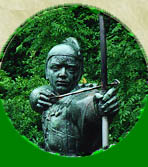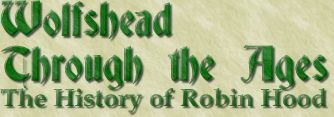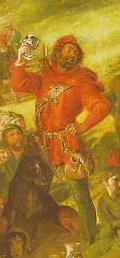
|
CHANGES TO THE ROBIN HOOD LEGENDRevolutions and RomanticismThe street ballads were being constantly printed, but the Gest, the popular medieval ballad, was almost forgotten. That is until Joseph Ritson published his collection of Robin Hood tales in 1795, Robin Hood: A Collection of all the Ancient Poems, Songs and Ballads, now extant, relative to that celebrated Outlaw. It wasn't the first ballad collection, but it did have more scholarly footnotes and a greater adherence to the original text than most. The book was a smash hit, and remained so for the next 100 years. It was continually reprinted (including an 1832 edition revised after Ritson's death to add Robin Hood and the Monk as the ballad was unknown to Ritson in 1795). Ritson included a dozen-page summary of Robin's life (backed up by over 100 pages of explanatory notes). It recycled old points like the Locksley (Loxley) birthplace from the 1600 Sloane manuscript, Stukeley's Fitzooth family background and the few references to Robin helping the poor and oppressed. But it also made Robin a hero after Ritson's own heart. His Robin didn't give up venison to suit Ritson's vegetarianism. However, Joseph Ritson was also a firm believer in Tom Paine and the French Revolution. Ritson even kept the new and short lived French Revolutionary calendar. He made Robin Hood a fighter for freedom against tyranny and more openly opposed to the aristocracy than previous versions of the legend. Ritson described the outlaw hero as:
The Normans were originally Viking raiders who in the 10th century were offered a piece of prime French real estate -- what became the duchy of Normandy -- if they'd keep the other Vikings from raiding France. After a century or so, the Normans had adopted much of the French-like culture and language of the original Norman inhabitants (although their language, sometimes called "Norman French" wasn't quite what was spoken in Paris). They were doing quite well for themselves, and Duke William of Normandy invaded and conquered England in AD 1066. Later political writers crafted poetic myths around the supposedly lost Saxon political and religious traditions. (The Saxons were one of the Germanic tribes to land in England in the 5th century and the term is often used to describe "the English".) Largely the Robin Hood legend had not been drawn into the myth of the "Norman Yoke" although both 18th century ballad editors Thomas Percy and Joseph Ritson referenced the Norman hunting practices and forest laws when writing about the Robin Hood ballads. By the time of King Richard I and his brother, John, (when most Robin Hood stories were now set), some historians have argued the whole Saxon versus Norman conflict had cooled. But that didn't stop Sir Walter Scott from making the Normans the villains in his 1819 novel, Ivanhoe. Stephanie Barczewski in her book Myth and National Identity in Nineteenth-Century Britain: The Legends of King Arthur and Robin Hood notes that Scott's use of the Norman / Saxon conflict differed from previous writers. "His Saxons are Saxons and his Normans are Normans not because of the unique nature of their political institutions, which he all but ignores in Ivanhoe, but because of an inherent biological distinction between them." (p. 129) (Although she notes that Scott "stops short" of how far later writers took this idea.) Robin Hood and his men (principally Tuck under the alias the Clerk of Companhurst) are merely supporting characters. Stephen Knight says "Locksley's major role is to act as military support and security officer" and compares him to "the gruff non-commissioned officer who really runs the show in a 1940s British war film."(A Complete Study, p. 173). Knight speculates that Robin might only be in the background of Ivanhoe because Scott "may well have wanted to restrain the force of someone so inherently threatening from a Tory viewpoint." But as Barczewski states, "Scott's influence upon the subsequent treatments of the legend of Robin Hood can scarcely be exaggerated. " (p. 129) Although she doesn't state just how thoroughly Ivanhoe recrafted the Robin Hood story beyond the near-universal adoption of the Norman vs. Saxons story. Robin Hood and his men were only supporting players in Scott's novel, providing much needed back-up to the title character. Still, Robin's appearance in Ivanhoe influenced later tellings of the story. For example, through most of the novel, Robin goes by the name of Locksley, which Scott says "From the ballads of Robin Hood, we learn that this celebrated outlaw when in disguise, sometimes assumed the name of Locksley, from a village where he was born". Robin did this in the ballad of Queen Catherin. But I think it was Scott's use of "Locksley" which turned Robin (particularly the Robin of TV and movies) from Robin Hood, born in Locksley/Loxley into "Robin of Locksley" who only used Robin Hood as an alias. The success of Ivanhoe was simply astounding. Within a few months of its initial publication, there were at least six stage versions of the story - often competing for theatre goers attention on the same night. It has been adapted into operas, spin-off novels and comic books. And usually, Locksley and the other Robin Hood characters make an appearance in these adaptations. Ivanhoe was one of the most read novels for generations, and so its effect on the legend is not surprising. While the Robin Hood of the novel is not that different from his ballad counterpart, many of Sir Wilfred of Ivanhoe's characteristics later became associated with Robin Hood. Sir Wilfred is an ex-Crusader who is disinherited and estranged from his father. Ivanhoe fights Normans and rescues his lady love. None of these plot points appear in the Robin Hood ballads, but they are now a part of Robin's character in most modern movies and novels. And while Will Scarlet does a similar trick in a long-lost version of the Queen Catherin ballad, Ivanhoe features the first time that Robin Hood wins the archery contest by splitting an arrow. Robin Hood filmmakers have found this image to be irresistable. At the time Ivanhoe was being written, Robin Hood was having a resurgence of popularity. In 1818 J.R. Reynolds wrote two sonnets to his friend the Romantic poet John Keats. Reynolds described the heroes of legend coming alive through imagination, Robin Hood with his "trusty bow well gathered of the yew" and Maid Marian "Oh gentle tressed girl". Keats's response was the poem usually titled "Robin Hood: To A Friend". But as Stephen Knight remarked Keats played with "Reynolds' notion of revivifying Robin and Marian to comment on what they would see in our time, not on what we would feel for them." (Knight, p. 163) And if Robin should be cast Another of Keats's friends, Leigh Hunt, was at work on Robin Hood "verse narratives", the first of which was published in 1820. In "Robin Hood's Flight", Robin Hood poaches a deer to feed Will Scarlet (or Will Nokes, depending on the version) and kills the abbot who tries to seize them. (When Errol Flynn's Robin saves Herbert Mundin's Much in the 1938 movie, a version of this scene becomes firmly entrenched in the Robin Hood lore.) Also, the liberal and satirical Thomas Love Peacock published his novella Maid Marian in 1822. However, Peacock's introduction stated that all but the last three chapters were written in 1818 - prior to Ivanhoe - although the latter chapters show elements from Scott. Stephen Knight calls Peacock "the first , and in some ways, the most successful, writer to rationalize the Robin Hood materials into one structure." (p. 183). Prose lives and chapbooks had already woven incidents from the ballads together, but Peacock transformed the stories into something new. But as a satirist, Peacock also sent up the very traditions he was helping to shape. Later writers did not share Peacock's wit. But if Peacock was among the first and most successful writers to adapt the legend into long-form prose, he certainly wouldn't be the last. NEXT: Children's Novels and Comic Operas | BACK TO: Broadsides and Buffoonery | TOP | CONTENTS | FORWARD TO: Children's Novels and Comic Operas | Sources and Further Reading: Click here to view additional information sources used for this specific section. Text copyright, © Allen W. Wright, 1997 - 2013. |

 Nearly
25 years after Ritson, Robin Hood appeared in several novels and poems.
And although many of the writers were opposed to Ritson's radical politics,
their Robins also fought tyranny -- Norman tyranny in particular.
Nearly
25 years after Ritson, Robin Hood appeared in several novels and poems.
And although many of the writers were opposed to Ritson's radical politics,
their Robins also fought tyranny -- Norman tyranny in particular.
